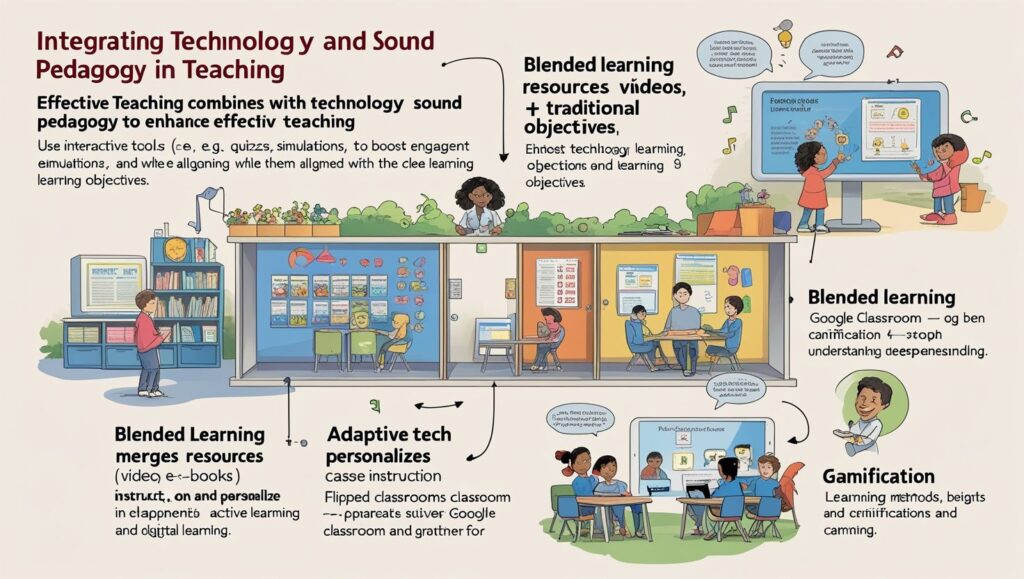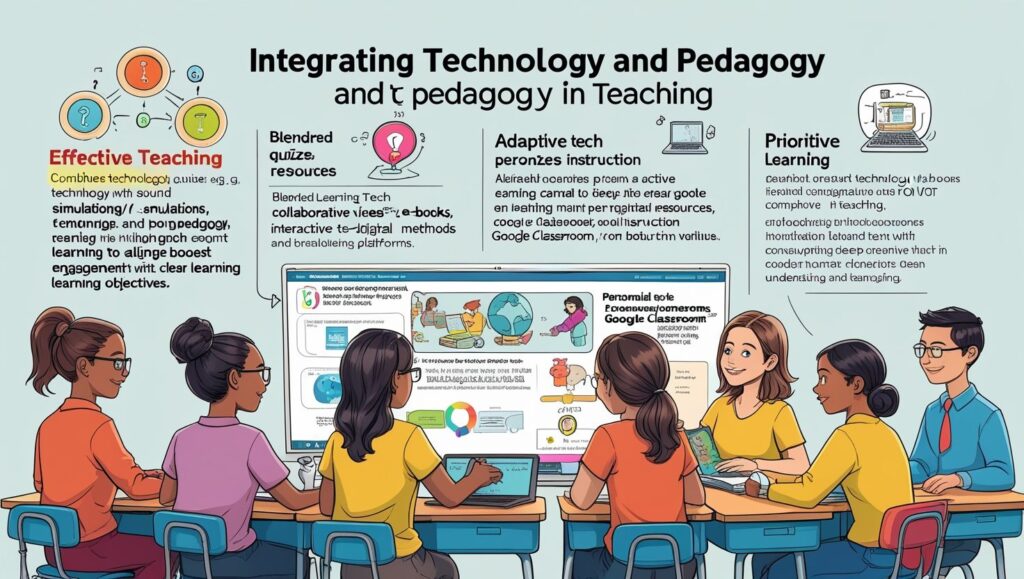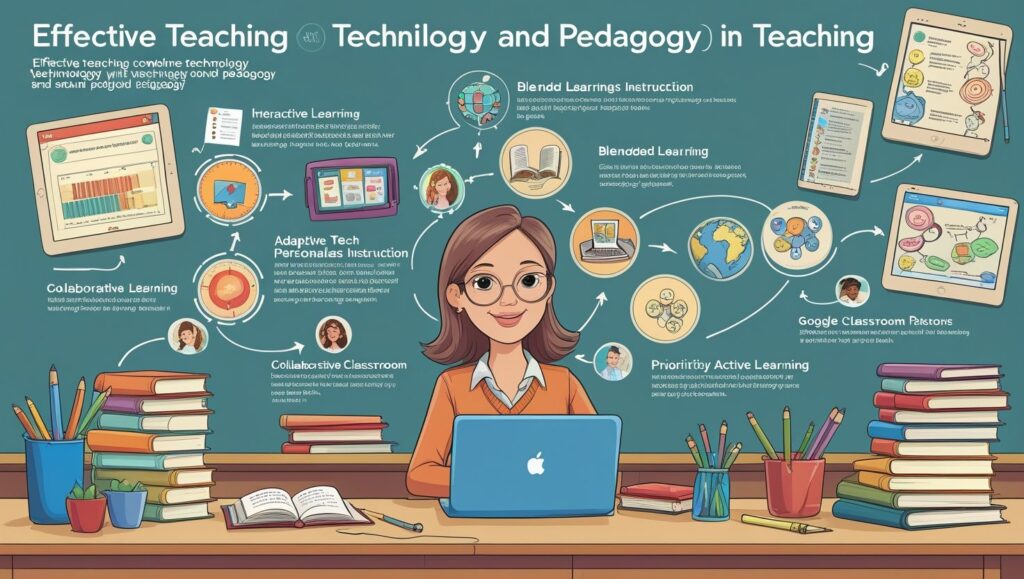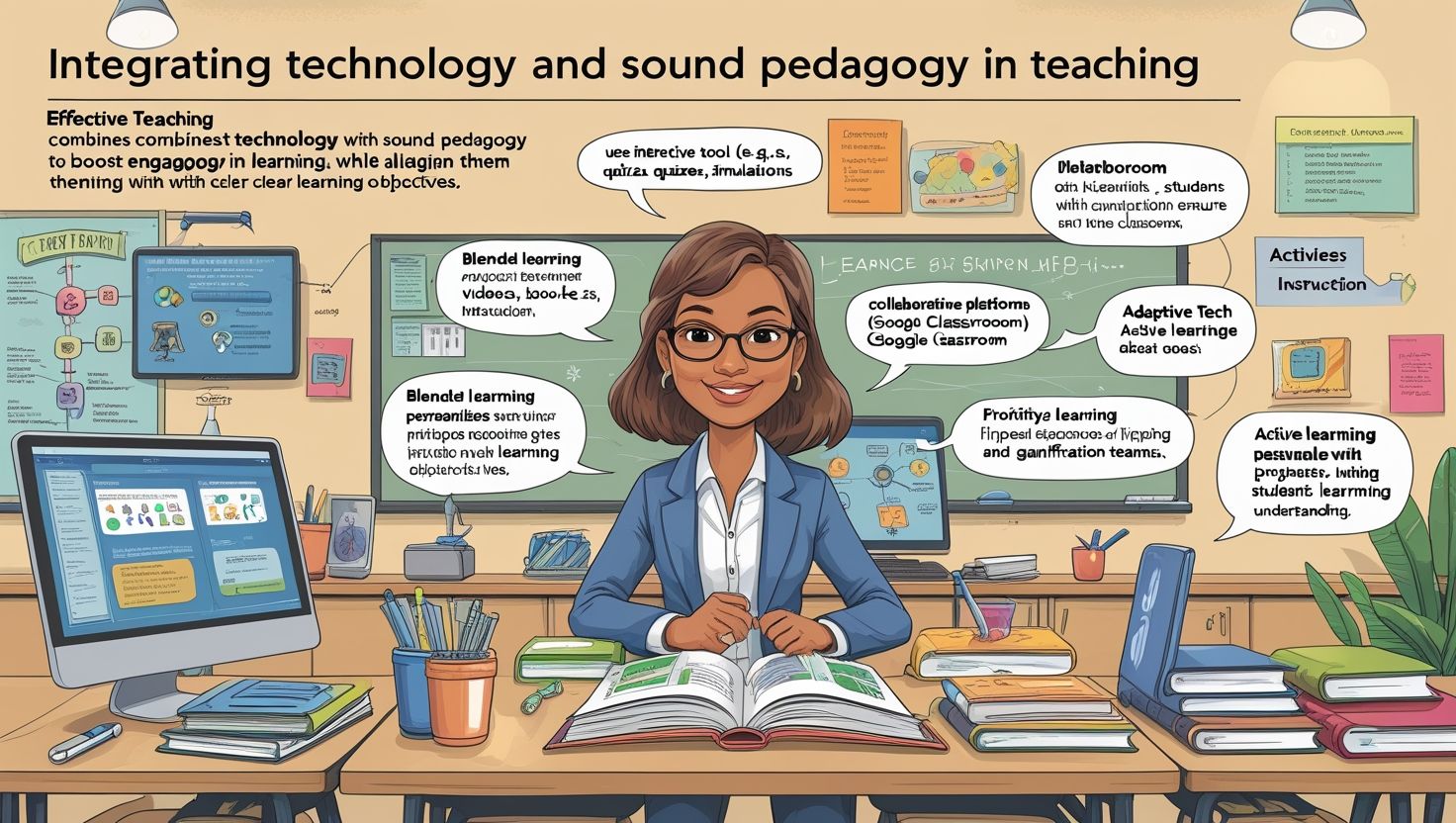Introduction
How to Use Technology and Pedagogy in Teaching, In today’s classrooms, education is evolving fast. Technology and pedagogy together are changing the way students learn. Technology provides tools. Pedagogy offers methods. Together, they make teaching more effective and engaging. Moreover, students are more familiar with digital tools now. Therefore, using technology helps connect better with them. Pedagogy, on the other hand, ensures learning stays meaningful. When teachers combine both, learning becomes smoother and deeper.
However, using technology alone is not enough. It must be guided by sound pedagogical practices. Similarly, good pedagogy without tools may not fully meet modern needs. That’s why integration is necessary. Furthermore, teachers need proper training. They must understand when and how to use digital tools. Equally, they should know which method best supports the content. Without this knowledge, efforts may not yield results.
In fact, combining these elements doesn’t mean replacing traditional teaching. Rather, it enhances it. It allows students to explore, collaborate, and reflect more effectively. Teachers can track progress better, too. Thus, technology and pedagogy must work hand in hand. Their proper use can uplift educational quality significantly. To achieve this, schools and educators need the right mindset, skills, and support systems.
Understanding Pedagogy: Foundation of Teaching
Pedagogy is the heart of effective teaching. It refers to the strategies, methods, and principles that guide how learning happens. Although technology is important, without sound pedagogy, it may fail to support real learning. First and foremost, pedagogy helps teachers decide what method to use. For example, group work may be best for discussions. In contrast, lectures might suit theory-heavy topics. So, pedagogy helps match methods to content.
Furthermore, it focuses on learners’ needs. Pedagogy encourages inclusive, differentiated, and student-centered practices. This means every learner’s style, pace, and background is respected. Consequently, students feel more motivated and involved. Also, pedagogy shapes classroom interactions. It promotes collaboration, questioning, and critical thinking. These are key 21st-century skills. Without proper methods, such outcomes are hard to achieve.
In addition, pedagogy includes assessment techniques. Teachers evaluate learning, provide feedback, and plan next steps. These actions ensure continuous progress. While tools may change, pedagogy remains constant. It reminds us that teaching is not just delivering content. It is about helping students understand, reflect, and grow. Thus, teachers must prioritize pedagogy first. Only then should they think about which technology can support that method best. This sequence ensures purposeful teaching.

Role of Technology in Modern Classrooms
Technology has revolutionized education in many ways. From chalkboards to smartboards, teaching tools have evolved rapidly. Today, students use laptops, tablets, and smartphones for learning. Teachers now rely on digital platforms, too. Importantly, technology improves access. It brings global knowledge to local classrooms. Students can explore topics through videos, virtual labs, and simulations. This makes learning more exciting and real.
Moreover, it supports personalized learning. Apps and software adjust to student levels. Some provide instant feedback. Others allow self-paced learning. As a result, students take more responsibility for their progress. In addition, technology supports teachers in planning. Online resources, lesson templates, and assessment tools save time. Teachers can also track performance through data dashboards.
However, technology is just a tool. If used blindly, it may distract rather than help. Therefore, it must align with learning goals. Teachers should ask: “What do I want students to learn?” Then, they should choose the right tool. Besides, not all students have equal access. So, teachers must plan for equity. Digital inclusion is as important as innovation. Overall, technology enriches the learning environment. When used wisely with pedagogy, it transforms classrooms into engaging, inclusive spaces.
Blending Technology with Pedagogical Strategies
Blended learning means combining traditional methods with digital tools. It is not about replacing the teacher. Instead, it gives teachers more ways to reach every student. This blend helps create flexible and personalized classrooms. To begin with, pedagogy must lead the way. Teachers decide the learning objective first. Then, they pick the right tool to meet it. For example, if the goal is collaboration, tools like Google Docs or Padlet work well.
Moreover, blended strategies promote active learning. Students no longer just listen. They engage through quizzes, games, and discussions. Platforms like Kahoot or Edmodo make learning fun and meaningful. In addition, flipped classrooms are a great example. Teachers assign video lessons as homework. Then, they use class time for discussions and activities. This approach encourages deeper understanding.
Furthermore, blended learning helps teachers monitor progress. Many platforms offer real-time reports. These insights guide instruction. If a student struggles, the teacher can intervene early. Despite the benefits, planning is essential. Teachers must balance screen time and physical interaction. Also, they must guide students on responsible digital behavior. In conclusion, blending pedagogy and technology requires thoughtful planning. But when done right, it boosts engagement, understanding, and independence among learners.
Practical Tools That Support Pedagogical Goals
Using the right tools supports good teaching. Many digital platforms align well with pedagogical goals. These tools assist with instruction, engagement, and assessment. But their use must be intentional. Firstly, for delivering content, tools like PowerPoint, Prezi, and Canva are useful. They help teachers present ideas clearly. Videos from YouTube or Khan Academy also add depth to lessons.
Secondly, for student engagement, interactive platforms are key. Kahoot, Quizizz, and Nearpod make learning competitive and fun. Students enjoy learning through games, which boosts attention. Moreover, collaboration tools such as Google Docs, Jamboard, and Microsoft Teams support group work. These tools promote communication, idea sharing, and critical thinking.
For feedback and assessment, Socrative, Google Forms, and Edpuzzle are effective. Teachers can track responses instantly. This helps in planning further lessons based on student performance. Also, tools like Padlet and Flipgrid encourage student voice. Learners can express their ideas creatively. This aligns with learner-centered pedagogy. However, using too many tools can confuse students. Teachers should select a few that suit their goals. Training is also important. Without knowing how to use a tool, it may fail. Therefore, tools are powerful. But they should always serve pedagogy, not dominate it.

Challenges in Integrating Technology and Pedagogy
While the benefits are clear, integration is not always easy. Many teachers face several challenges. These must be addressed for effective classroom use. First, lack of training is a major issue. Many educators are not confident using digital tools. Without proper guidance, they may misuse or avoid technology.
Secondly, infrastructure is often inadequate. Poor internet, limited devices, or outdated software affect smooth integration. Rural schools face these problems more often. Therefore, equal access is vital. Moreover, time is a constraint. Teachers have packed schedules. Learning new tools or planning digital lessons takes extra effort. Without support, they may stick to old methods.
In addition, digital fatigue is real. Too much screen time affects students’ health and focus. Teachers must maintain balance and include offline activities too. Furthermore, safety is a concern. Online platforms may expose students to risks. Teachers need to teach digital citizenship and monitor usage.
Resistance to change also blocks progress. Some educators prefer traditional methods. They may see technology as a threat, not a tool. Awareness and collaboration can help change mindsets. Overall, integration needs careful planning. Schools must support teachers with training, resources, and time. Only then will technology and pedagogy blend smoothly.
Professional Development for Effective Integration
To use technology and pedagogy well, teachers need professional development. It should be continuous, practical, and need-based. Without it, integration efforts may fail. Firstly, training should go beyond tool usage. Teachers must learn how to align tools with pedagogy. For example, how to use a quiz app for formative assessment—not just for fun.
Moreover, workshops should include classroom scenarios. Teachers must practice lesson planning, using both tech and pedagogy. Peer collaboration during training adds value. Additionally, ongoing support is essential. After workshops, teachers need help desks, tech coaches, or peer mentors. This helps them solve problems in real time.
Also, training must be flexible. Online modules allow teachers to learn at their pace. Platforms like Coursera, Edutopia, and Google for Education offer free and quality resources. Furthermore, reflection is key. Teachers should review what worked and what didn’t. This helps improve future lessons.
However, training is not one-time. With new tools emerging, teachers must stay updated. Therefore, schools should invest in regular professional development. In short, well-trained teachers can blend pedagogy and technology effectively. They feel confident, supported, and ready to innovate. Thus, teacher development is central to educational transformation.
Student-Centered Learning Through Technology and Pedagogy
The main goal of teaching is student success. By using pedagogy and technology wisely, learning becomes student-centered. This means students take charge of their learning. To begin with, student-centered learning values choice. Digital tools allow students to pick how they learn—videos, texts, or games. Pedagogical methods like inquiry-based learning support this approach.
Moreover, students work at their own pace. Technology provides personalized paths. Apps adjust to each learner’s level. As a result, slow learners get support, while fast learners stay challenged. Also, collaborative tools encourage teamwork. Students build projects together. They share ideas and learn from one another. This builds 21st-century skills like communication and creativity.
Importantly, assessment becomes formative. Teachers check progress regularly. Tools provide instant feedback. This helps students reflect and improve constantly. Additionally, learning becomes more relevant. Through simulations and real-world tasks, students connect theory to practice. They explore careers, solve problems, and think critically.
However, guidance remains vital. Teachers still plan, facilitate, and support. They create structure and safety for exploration. In conclusion, technology and pedagogy make learning more engaging, personal, and meaningful. They shift the focus from teaching to learning. And that’s where true education begins.

Future of Teaching: Innovation with Purpose
The future of teaching is bright—with thoughtful innovation. Technology will keep evolving. Pedagogy will continue guiding it. Together, they will redefine classrooms. Artificial intelligence, virtual reality, and adaptive systems are already entering schools. These tools offer immersive experiences. But without purpose, they may distract. That’s why pedagogy must remain the foundation.
Moreover, learning will go beyond classrooms. Students will learn anytime, anywhere. Platforms will connect global learners. Teachers will become facilitators, mentors, and co-learners. In addition, assessment will transform. Data-driven insights will replace one-size-fits-all tests. Teachers can tailor lessons based on actual needs. Learning gaps can be closed faster.
Furthermore, inclusive education will grow. Technology can support learners with disabilities. Pedagogical methods will ensure equal participation for all. However, with growth comes responsibility. Ethics, equity, and empathy must guide innovation. Students must learn to use technology wisely and respectfully. Teachers must model digital citizenship.
To prepare for this future, schools must invest in teacher development. Curriculum designers must blend tech and pedagogy. Policies must support experimentation and learning. Ultimately, the future of education is not about gadgets. It is about meaningful learning. And that happens only when pedagogy and technology work with vision and purpose.
Conclusion:
In conclusion, using technology and pedagogy together leads to better teaching and learning. Pedagogy provides the “how.” Technology offers the “what” and “where.” When aligned, they create engaging, inclusive, and effective classrooms. Moreover, technology alone is not the solution. Nor is old-style teaching enough. But their combination brings the best of both worlds. Students become active learners. Teachers become innovative guides.
However, success needs planning, support, and training. Without it, efforts may fall short. Therefore, professional development is key. So are digital resources and leadership. Additionally, challenges must be addressed. Not every student has a device. Not every teacher has training. Equity matters. Schools and systems must support all learners.
Looking ahead, education will keep changing. But strong pedagogy and smart technology use will always remain relevant. They help build thinkers, creators, and responsible citizens. So, teachers must continue to learn. Schools must continue to invest. And students will continue to thrive. In the end, it’s not about choosing between tradition and innovation. It’s about harmonizing them—for the future of learning.

I appreciate the honesty and openness in your writing.
I love how practical and realistic your tips are.
I hadn’t considered this angle before. It’s refreshing!
Your content never disappoints. Keep up the great work!
It’s great to see someone explain this so clearly.
You clearly know your stuff. Great job on this article.
This article came at the perfect time for me.
This gave me a lot to think about. Thanks for sharing.
This topic is usually confusing, but you made it simple to understand.
This was very well laid out and easy to follow.
78gxn5
jbygwo
https://t.me/s/Official_1win_kanal/1710
https://t.me/s/Webs_1WIN